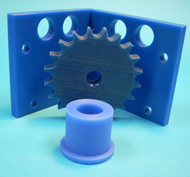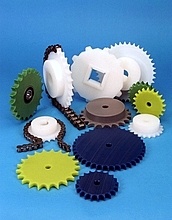 Plastics have long been identified as some of the safest and most efficient materials for a variety of uses in the food industry. Plastic sprockets are a fundamental part of any food industry conveyor system and processing machinery because their physical properties including wear resistance, wide operating temperature ranges, and superior tensile strength offer a number of crucial benefits.
Plastics have long been identified as some of the safest and most efficient materials for a variety of uses in the food industry. Plastic sprockets are a fundamental part of any food industry conveyor system and processing machinery because their physical properties including wear resistance, wide operating temperature ranges, and superior tensile strength offer a number of crucial benefits.
Slideways, Inc.
Recent Posts
Benefits of Plastic Sprockets in the Food Industry
Sep 8, 2016 2:14:00 PM / by Slideways, Inc. posted in plastic, conveyor systems, food transportation, plastic sprockets
Custom Plastic Assemblies
May 13, 2016 4:35:00 PM / by Slideways, Inc. posted in custom, plastic, plastic assembly, custom plastic fabrication, custom plastic assembly
 While we might be better known for our standard high-quality, precision plastic molding and machined plastic parts for a wide range of industries and applications, we also provide quality custom plastic assemblies.
While we might be better known for our standard high-quality, precision plastic molding and machined plastic parts for a wide range of industries and applications, we also provide quality custom plastic assemblies.
Water Absorbent Materials: How to Select the Right Plastic Compound
Feb 17, 2016 9:04:00 AM / by Slideways, Inc. posted in plastic, polyethylene, water absorption
Selecting the perfect water absorbent material can be challenging. When considering a water-absorbing polymer material to use for a custom machined part and a specific application, some typical properties to evaluate are
- Temperature
- Impact strength, and
- Wear resistance
Thinking about how much water a plastic component can absorb might not come immediately to mind.
But like many materials, plastics can absorb water — although they aren't the best water-absorbing material.
Selecting the Right Plastic Material: Thermal Expansion
Feb 1, 2016 11:01:00 AM / by Slideways, Inc. posted in plastic, temperature stable, thermalplastic
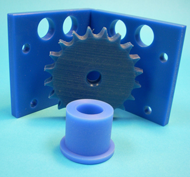 Plastics today are used in almost unlimited number of applications, many of which were previously handled by metal components, especially when the application required the part to be exposed to harsh conditions such as temperature extremes. Today’s modern plastic formulations are superior in many ways to previous generations of plastic materials; however, they come in a wide range of compounds and not all plastics are suitable for all applications. Every plastic formulation has its own unique characteristics, such as durability, tensile and impact strength, temperature range, and more.
Plastics today are used in almost unlimited number of applications, many of which were previously handled by metal components, especially when the application required the part to be exposed to harsh conditions such as temperature extremes. Today’s modern plastic formulations are superior in many ways to previous generations of plastic materials; however, they come in a wide range of compounds and not all plastics are suitable for all applications. Every plastic formulation has its own unique characteristics, such as durability, tensile and impact strength, temperature range, and more.
Selecting the Right Plastic Material: Impact Strength
Oct 25, 2015 10:49:00 AM / by Slideways, Inc. posted in plastic, impact strength, plastic supplier
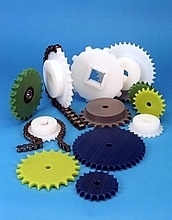 Unlike metals or ceramics, plastics are viscoelastic materials – that is, they respond to stress as if they’re a combination of a viscous fluid and a plastic solid. In other words, while plastics have solid-related characteristics such as stability of form, strength — and, yes, elasticity — they also possess fluid-like properties such as flow, which can be affected by temperature, rate, and time as well as the amount of loading.
Unlike metals or ceramics, plastics are viscoelastic materials – that is, they respond to stress as if they’re a combination of a viscous fluid and a plastic solid. In other words, while plastics have solid-related characteristics such as stability of form, strength — and, yes, elasticity — they also possess fluid-like properties such as flow, which can be affected by temperature, rate, and time as well as the amount of loading.
Heat Resistant Plastic: How to Select the Best Material
Aug 11, 2015 9:32:00 AM / by Slideways, Inc. posted in plastic, conveyor systems, friction, high speed, high-temp, heat resistant
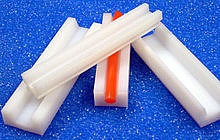 Plastic compounds come in a staggering array of formulations and materials for a wide range of industries, applications, and products. Selecting the right plastic material that offers excellent heat-resistant properties is critical for any application in which thermal properties can be adversely affected by the environment.
Plastic compounds come in a staggering array of formulations and materials for a wide range of industries, applications, and products. Selecting the right plastic material that offers excellent heat-resistant properties is critical for any application in which thermal properties can be adversely affected by the environment.
How Dry Lubricant Polyethylene Reduces Friction & Improves Performance
Mar 4, 2015 9:02:00 AM / by Slideways, Inc. posted in plastic, lower friction, uhmw, lubricant, polyethylene
 A proprietary, new high-performance ultra-high molecular weight (UHMW) polyethylene compound incorporates solid lubricants to offer a lower coefficient of friction. This significantly improved chain and belt performance in a wide range of conveyors and other material processing systems.
A proprietary, new high-performance ultra-high molecular weight (UHMW) polyethylene compound incorporates solid lubricants to offer a lower coefficient of friction. This significantly improved chain and belt performance in a wide range of conveyors and other material processing systems.
Introducing BluLub: The High-Performance Dry Lubricant Polyethylene
Metal Detectable Plastic and Its Benefits
Jan 28, 2015 2:45:00 PM / by Slideways, Inc. posted in uhmw
Metal detectable ultra-high molecular weight (UHMW) polyethylene is an ideal solution for rugged, wear-resistant moving components used in food processing, bottling and canning, packaging, pharmaceutical manufacturing—any system in which it’s critical to detect and prevent potential contamination threats that pose serious liability risks.
In this article, we'll show you what they are and how they work, plus features that make them unique and the benefits of using them.
But first...
Conveyor Components for Ultra-High Manufacturing Performance
Dec 17, 2014 10:13:00 AM / by Slideways, Inc. posted in conveyor components, plastic, fda compliant, uhmw, blulub, x-ray
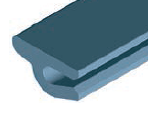
Demanding manufacturing processes faced with extreme environmental or stringent liability challenges need conveyor systems that can meet lofty standards of performance and reliability.
If you’re a discrete or process manufacturer operating in a tough production environment, high-performance plastic conveyor components can upgrade your conveyor systems to top efficiency.
Plastic Packaging Machinery Parts for Material Handling Operations
Oct 27, 2014 9:11:00 AM / by Slideways, Inc. posted in components, plastic, packaging, conveyor systems, equipment

Companies and processing plants looking for plastic components for their packaging machinery rely on Slideways to get lightweight, less expensive, and easy-to-maintain alternatives to metal parts. These components include:
- Plastic Bearings
- Rollers
- Pulleys
- Chain Guides
- Wear strips
- Belt Guides
- Star Wheels, and
- Conveyor Components


